B2C and B2B Marketing: Why Both Are Needed
We at Global Talent BPO (GTBPO) have seen that for years, healthcare marketers have focused on marketing to consumers namely B2C marketing. In 2022, healthcare digital ad spending increased by 14.3%, reaching $15.84 billion. That figure is projected to increase by12.3% in 2023 to reach $17.79 billion. In addition, healthcare providers are allocating 57.5% of their total ad spend to mobile devices.
The world of healthcare and life sciences is broad and diverse, with various institutions contributing to its ecosystem. Pharmaceutical companies, medical device manufacturers, healthcare IT firms, healthcare services organizations…all of these businesses play a critical role with unique missions and markets.
B2B healthcare companies like these have distinct marketing challenges to overcome. Unlike B2C healthcare marketing targeting patients with specific needs, B2B healthcare marketing requires a comprehensive understanding of the buyer’s journey and sales cycle, considering everyone from administrators and procurement professionals to chief executives, board members, and clinicians.
For effective marketing to healthcare professionals, we at GTBPO develop a holistic view of our client’s target market, buyer personas, buyer’s journey, and how our solution and services uniquely addresses their needs. Then, we effectively communicate our value proposition to each stakeholder on the proper marketing channel, at the right time.
B2B Marketing for Healthcare Providers
GTBPO works closely with its clients as a demand generation service provider uniquely built to help its clients measurably improve business performance. We focus on three interdependent drivers of growth: Branding, Lead Generation, and Customer Engagement, with a view to attract, secure, and retain profitable customers for our clients.
B2B: A Whole Different Animal
B2B audiences are an interesting breed. They are consumers by nature, yet rarely make decisions on impulse. They are highly qualified in their fields, yet are always looking to learn something new. Most B2B sales are considered sales, as there are enough complexities involved in them for buyers to research different options. For these reasons, many B2B companies employ a sales force in addition to their marketing efforts to help close the sale.
In healthcare, it is not uncommon for hospitals to employ physician relations departments as their B2B sales forces. Physician relations performs this function with the physicians as the customer, along with customer service, consulting, and a few other roles mixed in. In the end, it is their job to build and nurture relationships with referring physicians. Traditionally, this was done through face-to-face encounters, as physician liaisons visiting referring physicians’ offices regularly with updates on services and referral materials and to follow up on satisfaction with the referral relationship.
Likewise, when physician liaisons sought to establish a new referral relationship, they made frequent stops into the offices of potential referral partners in the hope of creating a connection, gauging referral potential, distributing educational material, and scheduling face time between the physician they represent and the potential referring physician.
But these face-to-face connections among hospitals, hospital-based physicians, and referring physicians are becoming less frequent. In part this is partially due to some hospitals shrinking or even eliminating their physician liaison programs. However, the work life of the modern physician also plays a role, as does the growth of new technologies and changing preferences in terms of how they receive information.
The implications of this shift are clear: healthcare marketers must be supplemented with new marketing techniques to form a comprehensive physician marketing strategy. Just as B2B companies utilize marketing and sales, so must healthcare providers.
Reasons to Market to Physicians
There are a number of reasons healthcare providers market to physicians. Think of them as three ‘R’s:
- Recruitment: We have all seen the stats. There will be a shortage of more than 100,000 physicians by 2030. Providers around the country are looking for the best ways to market physicians and entice them to call their organizations home. Physician recruitment usually lives in the HR function rather than marketing, but wherever it resides, you first need to hire amazing doctors before you can start advertising for them or to them.
- Reputation: Each summer, U.S. News & World Report releases its influential list of best hospitals in the nation. Like them or hate them, consumers find these rankings useful. As a result, a lot of resources are committed by providers participating in the ranking survey process, and to say nothing of the advertising arms race that occurs post-publication. According to U.S. News, nearly 30% of their score calculation comes from expert opinion — board-certified physicians across the country in the 16 specialties ranked in the Best Hospitals issue. Due to this methodology, physicians have a magnified role in determining hospital reputations. This has led many hospitals to now target them with communications programs designed to increase familiarity and favourability for their institution, service lines, and own top-rated physicians.
- Referral: As the healthcare industry becomes more competitive, healthcare providers struggle with referral including network integrity. Recently, even prominent institutions have seen out-migration rates creep into the double digits. In this environment, keeping physicians informed about your hospital’s strengths (e.g., procedural expertise, key hires, and facilities upgrades) is essential. Hospitals need to communicate these things on a regular basis, but as health systems get larger, connecting with individual doctors becomes harder. This is where marketing comes in.
The Physician Persona
B2B audiences are an interesting breed. They are consumers by nature, yet rarely make decisions on impulse. They are highly qualified in their fields, yet are always looking to learn something new. Most B2B sales are considered sales, as there are enough complexities involved in them for buyers to research different options. For these reasons, many B2B companies employ a sales force in addition to their marketing efforts to help close the sale.
In healthcare, it is not uncommon for hospitals to employ physician relations departments as their B2B sales forces. Physician relations performs this function with the physicians as the customer, along with customer service, consulting, and a few other roles mixed in. In the end, it is their job to build and nurture relationships with referring physicians. Traditionally, this was done through face-to-face encounters, as physician liaisons visiting referring physicians’ offices regularly with updates on services and referral materials and to follow up on satisfaction with the referral relationship.
Likewise, when physician liaisons sought to establish a new referral relationship, they made frequent stops into the offices of potential referral partners in the hope of creating a connection, gauging referral potential, distributing educational material, and scheduling face time between the physician they represent and the potential referring physician.
But these face-to-face connections among hospitals, hospital-based physicians, and referring physicians are becoming less frequent. In part this is partially due to some hospitals shrinking or even eliminating their physician liaison programs. However, the work life of the modern physician also plays a role, as does the growth of new technologies and changing preferences in terms of how they receive information.
The implications of this shift are clear: healthcare marketers must be supplemented with new marketing techniques to form a comprehensive physician marketing strategy. Just as B2B companies utilize marketing and sales, so must healthcare providers.
- THEY DON’T DO DESK: The majority of physicians aren’t sitting in an office each day, and their busy schedules have made them one of the first professions in the U.S. to be truly mobile-first.
- AN APPLE A DAY: Roughly 85% of doctors are iPhone users, compared to 32.5% of the general population who choose the Apple phone over any Android model.
- THEY’RE NETWORKERS: From late-night med school cram sessions to working in multiple clinics or hospitals, doctors rely heavily on professional networking throughout their careers.
- PRIVACY RULES: Due to strict HIPAA regulations requiring all patient-related communications to be encrypted, doctors are virtually banned from using email and SMS messaging in their daily work.
- SPECIALTY MEANS SPECIALNESS: Much of what physicians practice is extremely specific. Writing something for a cardiologist? Consider whether they are electrophysiologists, interventional cardiologists, or even better, interventional cardiologists with a focus on coronary artery stents.
- THEY DIFFER (EVEN AMONG THEMSELVES): Various studies have been done linking medical specialties and Myers-Briggs personality typing. In the one such study, neurosurgeons fell into three personality types (The Logistician, The Commander, and The Architect). Physicians in one specialty may not only differ against the general population, but against other specialties as well.
- CONTENT IS KEY: Physicians as a group are highly sceptical, well-informed, and opinionated. They are turned off by consumer-centric messaging and marketing fluff.
Best Practices
Many hospitals are still designing websites for desktop computers and then trying to shoehorn them onto mobile devices.
- BE AN INFORMATION PARTNER: Studies have shown that medical professionals prefer marketers to act as information partners. Content marketing designed to establish their thought leadership in a specific area(s) builds trust as this is critical for referrals and reputation building. Our clients have told us that developing strong clinical content is their toughest challenge, but it is one that must be met because providing useful, relevant information and education is the best way to not only get their attention, but also to earn credibility.
- OPT-IN IS THE GOAL: There are many great channels out there for reaching physicians, however, the costs to use them can spiral to the point of unprofitability. That is why email is critical. Aside from being a preferred channel by physicians themselves, it is the most cost-effective way to communicate on an ongoing basis. Note that this does not mean buying email lists, which is a worst practice, but rather getting physicians to opt-in to future communications because they value your content or partnering with a trusted distribution source and leveraging their subscriber base.
- MOBILE FIRST: Many hospitals are still designing websites for desktop computers and then trying to shoehorn them onto mobile devices. For the physician on a mobile device, your content needs to be concise and clear, and your design minimalist. Additionally, consider using video in an engaging and mobile-friendly format. Also, feature peers rather than patients. Physicians prefer a more clinical perspective when reading about new treatments or technology.
- THERE IS NO MAGIC BULLET: We ex[lore and go with what works to deliver results to our clients. If that means using unglamorous newsletters and direct mail, so be it. If it means using the latest programmatic media techniques like using artificial intelligence and real-time bidding techniques to target physicians wherever they go on the web or geofencing conferences and sending relevant messages to smartphone users who enter a predefined location, do that. Marketing to physicians is an imperfect science, and what works for one organization may not work as well for another.
Putting It in Context
CONTEXTUAL ADVERTISING is the placement of ad campaigns on websites or site pages that are directly relevant to the ad we are running.
In B2C, if we are selling a kitchen mixer, for example, we try to have it placed on sites listing recipes for cakes. The idea here is that people who are interested in baking are more likely to want a mixer than someone on a video gaming site. A more interested audience usually means better click-through rates and more conversions, so contextual advertising is a great way to improve the performance of your marketing.
There are now a growing number of advertising- funded sites with content developed specifically for physicians. We will review select ones, but before we do …
Sites like Twitter, LinkedIn, YouTube, Facebook, and Google are all used by physicians even when they are just not contextually in sync with them. The sites we will cover all reach physicians, but they are utilized differently. A news site is likely to be visited by physicians 2–3 times a week, while a reference site is likely to used 2–3 times a day.
These sites do not represent the beginning and end of physician communications. According to a 2021 HealthLink Dimensions survey of more than 700 physicians, email followed by interactions via in-person visits (physician liaisons) and direct mail are still the preferred channel for receiving industry news, announcements, research, and educational opportunities.
Capturing physician attention and persuading them to change long-standing referral patterns or opinions about particular institutions usually takes a concerted, omni-channel effort to succeed. We use specific advertising funded sites as set of digital marketing tools that enable us to pursue that effort in contextually relevant way.
The sites we will cover all reach physicians, but they are utilized differently. A news site is likely to be visited by physicians 2–3 times a week, while a reference site is likely to used 2–3 times a day:
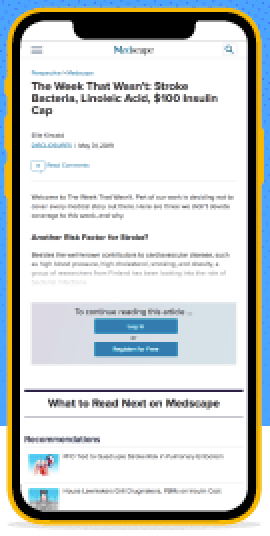
Medscape
We think of Medscape as The New York Times of medicine. It is a premier source for medical news, clinical reference, point-of-care tools, and medical education for physicians. Owned by WebMD, Medscape boasts a 55% physician reach on mobile. Its precision targeting and ability to present brand messages to physicians through the flow of their day (apps, site, tools) and across devices make it a go-to resource for B2B healthcare marketing.
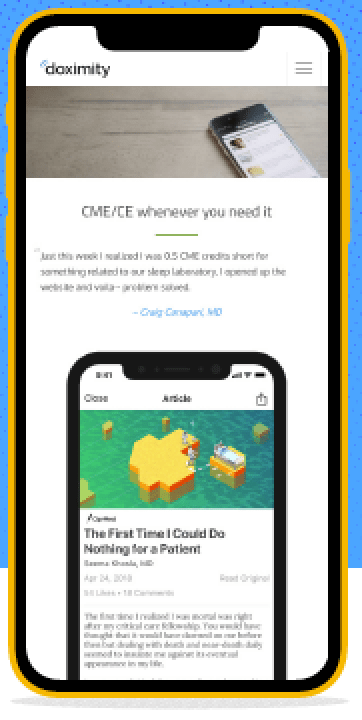
Doximity
While doctors are highly social, you will not find them connecting to each other on Facebook or LinkedIn, at least for their day-to-day work and this is where Doximity comes in. Billing itself as the Newsfeed of Medicine, Doximity’s fast-growing audience now exceeds that of the AMA as it has over 1 million members. While it (proudly) does not allow banner ads, it offers marketers an effective media mix through its Colleague Connect® and DocNews® products.
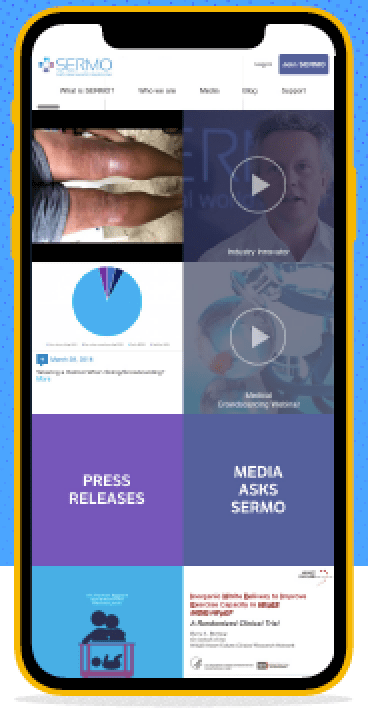
Sermo
If Doximity is the LinkedIn of medicine, SERMO is the Facebook. This social media site acts as a virtual doctors’ lounge in which practitioners vent about anything and everything. Since 90% of SERMO’s users remain anonymous, the site’s medical crowdsourcing feature does not run afoul of privacy laws. Much of the current advertising is from pharma companies, but that could change if this intriguing functionality takes off.
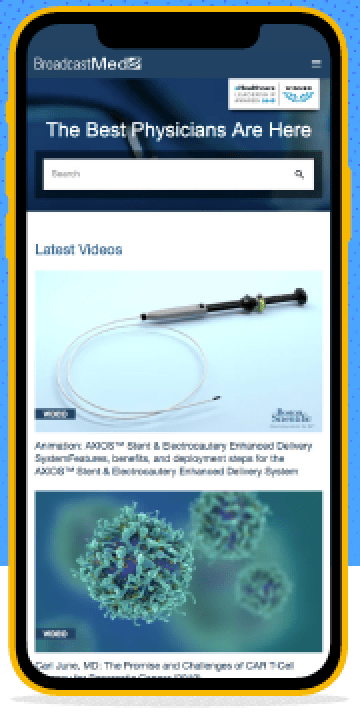
BroadcastMed
A recent Johns Hopkins study found that YouTube was the most valued social media channel by physicians and not surprising considering the instructional power of video. BroadcastMed, a contextual channel similar to YouTube, was first in the world to broadcast live surgeries on the internet using its ORLive solution and is still going strong after nearly 25 years. It lets industry participants post their educational content and run targeted campaigns towards the physician audience that they are looking for.
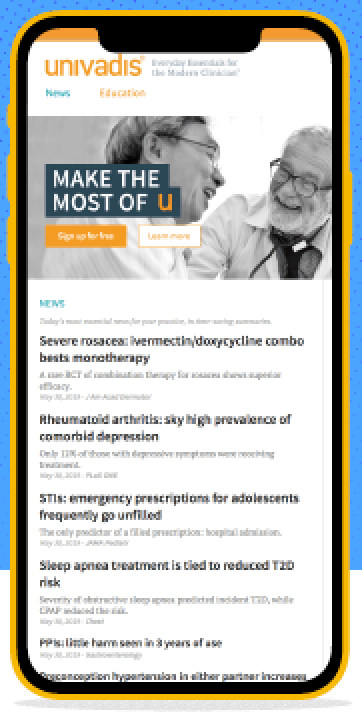
Univadis
Univadis uses concise executive summaries to help physicians tame the onslaught of medical literature and stay up to date in just a few minutes per day. While the site has morphed a bit, it was started by Merck, and absorbed peer-to-peer physician network QuantiaMD a few years back, and its current owner, Aptus Health, has made it a platform that features sponsored content delivered through various market access pull-through programs.
Our B2B Marketing Strategy
Here are our 6 most effective strategies for marketing to healthcare professionals:
- 📝 Prioritize Personalization: As we said before, no two entities in the healthcare industry are the same. Knowing what kind of content appeals to each buyer persona and what marketing channels they frequent are crucial for effective B2B healthcare.
We condense marketing targets into a specific list of individuals most aligned with our clients buyer personas and, therefore, most likely to become leads. - 🤝 Build Trust Through High-Quality Content: To nurture buyer personas properly, we provide quality content that speaks to their needs. Resources such as demo videos, case studies, blogs, and concrete examples of our clients proven services speak volumes to potential buyers and help solidify their legitimacy as leader in their industry.
Word-of-mouth referrals and networking are massively influential in the healthcare industry, and cultivating trust and long-term relationships through quality content is key to increasing and maintaining engagement.
While this may be an opinionated statement, it is fair to assume that healthcare executives and decision-makers are knowledgeable individuals. Therefore, they are naturally sceptical and analytical and will only engage with content they find valuable and stimulating.
- 💻 Enhance Our Clients Digital Expertise: While traditional marketing techniques bring tremendous value to campaigns, digital B2B healthcare marketing is more important than ever when trying to reach professionals in the healthcare industry. Digital marketing optimized for mobile is the magnum opus of marketing to healthcare professionals. These busy individuals are more likely to consume this content on a mobile device compared to other industries, and 85% of these people are iPhone users. Leveraging search engine optimization (SEO) practices to most effectively target your audience through relevant keyword research and competitor insights will help focus your digital marketing efforts more effectively for successful lead generation.
Paid advertising with search engines through pay-per-click ads and paid ads on social media can also boost your marketing efforts and help your content get right in front of its target audience. While not the cheapest option, paid marketing allows the unmatched flexibility to break down targets by demographics and focus your efforts on carefully selected groups.
Incorporating digital marketing through Google, social media, or other channels is key to reaching on-the-go healthcare executives checking their feeds or emails or surfing the internet in fleeting moments when they get the chance. Meeting your marketing targets in those moments and making meaningful impressions are vital when marketing to healthcare professionals.
- 📩 Create Multiple Touchpoints: We create as many touchpoints as possible to significantly boost marketing efforts when our clients buyer personas are as busy and hard-to-reach as they are in the B2B healthcare. While in-person marketing tactics are less likely to work for busy healthcare professionals, we create multiple touchpoints through paid traditional or digital advertising, social media, and emails that increase lead generation as our targets become more familiar and trusting of our client’s company and offerings.
- 🤳 Incorporate Social Media Advertising: As with most modern marketing methods, social media is vital when marketing to healthcare professionals. A robust online presence and remaining engaged with your followers help solidify authenticity, trust, and thought leadership. B2B healthcare is no exception to this principle.
Since many healthcare decision-makers are busy individuals, only checking their phones and feeds at night or during intermittent breaks, social media posts—whether posted organically or through the platform’s advertising options—may be the only chance you have to reach them. For this audience, LinkedIn and Twitter are your best options.
Social media also allows you to grow your brand and voice in the B2B healthcare industry and is a vital tool for sharing your content to build trust throughout the community. A solid social media presence is key to cultivating concrete relationships with buyer personas through paid or organic content.
- 📊 Learn From Your Analytics: We always pay close attention to data generated by our marketing efforts, both paid and organic. Most channels maintain dashboards that give insight into our market performance. We use these to our advantage. One of the most effective ways to improve our marketing efforts is learning how to replicate what works and how to remedy what doesn’t.
We implement A/B or tests and try different techniques to discover what works best for the audience. All data is valuable, and what we choose to do with it determines how much it can benefit our client’s company.
Starting a Pilot Program
The outcomes of a physician marketing program will differ depending on the objective of the program i.e. Recruitment, Reputation, Referral. There are basic measurements, however, that can be used across all objectives like engagement, perception, and behaviour. Each of these has different metrics associated with them. We keep these in focus, and make appropriate and timely adjustments to strategies and tactics where and when needed. If your organization is new to B2B marketing, it may be beneficial to conduct a pilot program with GTBPO in one or two service lines in order to perfect the process. Pairing with an experienced partner like GTBPO can help as well as we bring different experience and perspective to your physician marketing.
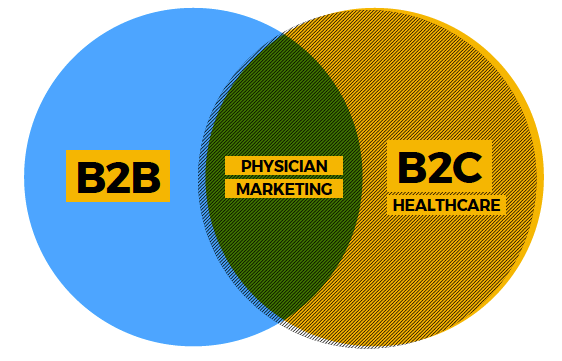
For over 10 years, GTBPO has worked with our partners in two market sectors — B2B and B2C healthcare. Physician marketing, whether it be for a hospital, health system, or a medical manufacturer, is nothing new to us. It lies at the very intersection of what we do.
Even if you have a B2C agency or a strong internal team, GTBPO can bring different experience and perspective to your physician marketing.
Outcomes

- ENGAGEMENT: B2B digital programs are highly measurable. Primary metrics include REACH (impressions delivered), RESPONSE (clicks and visits) INTERACTION (time spent, link activity), and AMPLIFICATION (content shared with colleagues).
- PERCEPTION: Perceptual metrics can take time to change. Initial benchmark and post-campaign quantitative research can measure positive trend in FAMILIARITY, FAVORABILITY, and INTENT.
- BEHAVIOR: Desired behaviours — increased referral, network integrity, or institutional ranking, for example — typically lag behind engagement and perception changes. Although accretive, gains can be significant and long lasting.
Physician Referral Marketing
Without clear physician referral marketing or patient referral strategies, most medical practices or physician groups are simply opening their doors and hoping for patients to walk in, often with little or slow success. In today’s market, it takes 2-5 years for a medical practice to hit a full patient volume capacity. At GTBPO, we aim to cut that time in half through our unique and direct field marketing program that no other company in offers. We target your most important physician referral or patient referral audience and push to gain awareness of your services and the opening of your practice.
By putting into place a clear and measurable referral system, it is possible to create multiple streams of new patient referrals for a simple monthly cost. As a reminder, every new patient referral submitted during and after the term of our 6 or 12-month contract is absolutely free.
Most medical specialists rely heavily on patient referral or “word-of-mouth” marketing to be successful, which is why GTBPO focuses on promoting your name directly to top referring physicians in your geographic area to increase exposure. First, we aim to see every referring practice and local pharmacies to within a 10-15 miles radius of your zip code. We then tailor a call cycle to promote to the most beneficial offices that can consistently send you patients.
Because this is a results-oriented program, you will receive a monthly Activity Report from your Physician Liaison, which will outline who we spoke with, on what date and the focus of the conversation. In each office visit, we aim to visit not only with the leading physician, but also the office manager, nurses and most importantly, the patient referral coordinator. Your Physician Liaison will meet with you at the end of every month to go over monthly results and future physician referral marketing plans. We will also remain in constant contact with you to discuss progress and keep you informed on new challenges in the healthcare industry.
Please give us a call and we wll begin with an in-depth evaluation of your practice, your specialty and the challenges you’re currently facing in growing your practice, in order to tailor a specific marketing strategy to finding you new patients.
GTBPO represents all major physician specialties and sub-specialties for Referral Marketing, such as:
- Allergy and Immunology
- Anesthesiology
- Cardiology
- Dermatology and MOHS Surgery
- Endocrinology
- Gastroenterology
- Geriatric Medicine
- Infectious Disease
- Nephrology
- Neurology and Neurosurgery
- Oncology and Hematology
- Ophthalmology
- Orthodontics
- Orthopedics
- Otolaryngology (E.N.T.)
- Pain Management
- Pediatrics
- Plastic Surgery
- Psychiatry
- Pulmonary Disease
- Radiology
- Rheumatology
- Surgery
- Urology

